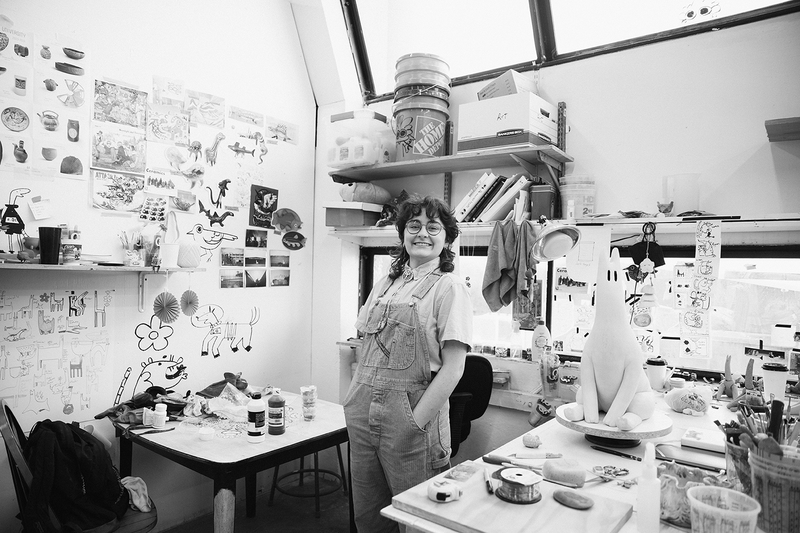Celebrating the Little Joys: Sophia Koch-Holdsworth (’25 Ceramics)
02.03.2025
Sophia Koch-Holdsworth's work focuses on capturing life’s small moments of joy—those spontaneous bursts of happiness that often go unnoticed but can leave a lasting impression.
From funny fortune cookies to the sight of a particularly fat squirrel, Sophia seeks to preserve and celebrate these fleeting, delightful experiences in their art.
A Playful Approach to Art and Life
The sculptures are instantly recognizable for their distinctive, playful form—squat and stubby with wide eyes and perky ears. These figures often evoke the spirit of dogs or even the compact chunkiness of the Pokémon Chikorita, but they carry a personality all their own.
Drawing inspiration from the traditional Swedish Dala horses, Sophia has developed a style that blends the charm of folk art with a modern, quirky twist. By keeping the forms round and approachable, they create sculptures that are both simple and memorable, with an unmistakable sense of character.
For Sophia, the “Little Joys” aren’t just inspiration for their artwork—they’re a guiding principle.
“I don’t like making work about big, capital-J joy,” Sophia explains. “Other artists do that really well, but I’m more interested in the small joys that happen every day. The kind of things that make you laugh or smile without even thinking about it.”
These little joys, as Sophia describes them, act almost like guardians, reminding us to appreciate the simple pleasures in life. These figures, though not designed to ward off evil spirits like ancient tomb guardians in Chinese art, have their own purpose: to keep us grounded and connected to the everyday moments that make life beautiful.
From Childhood Creativity to Artistic Exploration
Though Sophia can’t recall the exact moment they first picked up a pencil, their early childhood works were often found on anything but paper—furniture, walls, and more. “I drew on so much furniture as a kid,” they share. “But the one drawing I still have from childhood is of a nature goddess with a rabbit next to her. I tried to recreate it in high school, but it just didn’t feel the same.”
They fondly recall playing a drawing game with their family, called "beat that," during long drives for day trips. “We’d sit in a circle, each person drawing something, and the next person would draw something that could ‘beat’ the previous creation—no death or black holes allowed,” Sophia laughs.
As a teenager, Sophia would purge old drawings while cleaning their room—only keeping the ones that felt authentic. “I was very critical of myself,” they reflect. “But I guess that’s part of the process of finding your voice as an artist.”
Sophia also experiences life in a way that most people are unfamiliar with. They live with aphantasia, a condition where individuals are unable to create mental images. For Sophia, this means that when they think of something, they do not "see" it in their brain.
"I don’t see anything in my mind," they explain. "I have a hard time imagining things, and that’s kind of part of my process in terms of how I make work. I think in a very tactile way, and I’m much more focused on things that I can hold, shape, or manipulate."
“I like the idea of being pushed. Like, it’s good to have that push, and it’s nice to feel like you’re in a community that is supportive."
Life at KCAI
Sophia Koch-Holdsworth’s decision to attend the Kansas City Art Institute (KCAI) came from encouragement from a high school art teacher, plus a desire to be part of an environment that would nurture their growth as an artist.
“I like the idea of being pushed. Like, it’s good to have that push, and it’s nice to feel like you’re in a community that is supportive. But also, you have that push where you know you’re working really hard and really learning things... it feels good because you’re developing yourself and your voice as an artist,” Sophia said.
KCAI’s Ceramics Department has a structured yet flexible atmosphere that encourages students to develop their personal voices while learning technical skills. It’s a place where students can experiment freely, but it’s also a space where guidance from faculty ensures they’re honing their craft in ways that are intentional and meaningful.
“I think part of it, yes, is being part of a community that is so supportive, but also, you have that push where you know you’re working really hard and really learning things… it feels good because you’re developing yourself and your voice as an artist.”
Sophia also shares a love for animals, particularly dogs, which often appear in their work. Their connection with their pets is as deep as their connection to their art. “Pepper was a sassy little dog with so much attitude—she felt like the reincarnation of someone,” says Sophia.
“Chewy is still with us, and she’s this old, quirky dog we found through a connection with my dad, who’s a bereavement coordinator. It’s funny how life works, especially when you find things like that.”

Sophia in Studio